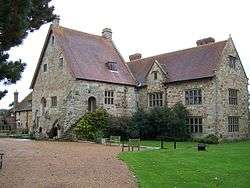Michelham Priory
|
Michelham Priory | |
 Location within East Sussex | |
| Monastery information | |
|---|---|
| Full name | Priory of the Holy Trinity |
| Order | Augustine |
| Established | 1229 |
| Disestablished | 1537 |
| Mother house | Hastings Priory |
| Dedicated to | Holy Trinity |
| People | |
| Founder(s) | Gilbert de Aquila |
| Site | |
| Location | Upper Dicker, East Sussex |
| Public access | Yes |
| Other information | Grid reference TQ 5587 0930 |
| Website | Michelham Priory website |
Michelham Priory is the site of a former Augustine Priory in Upper Dicker, East Sussex, England, United Kingdom. The surviving buildings are owned and administered by the Sussex Archaeological Society and are Grade I and Grade II listed.[1]
A T-shaped stone-built structure, the east and north wings date from the 13th century and the west wing from the 16th century. The north wing, originally the Priors Lodging, comprises three storeys with an attic and the other two wings two storeys. The roof is tiled. The whole is surrounded by a moat, enclosing an area of almost 8 acres (3.2 ha).[2]
A watermill in the grounds of the priory has been restored to working order and is open to the public.
History
The Augustine Priory of the Holy Trinity was founded at Michelham in 1229 by Gilbert de Aquila,[3][4] whose father had been a benefactor at Bayham Abbey, Kent and was also connected with Otham Abbey, East Sussex.[5] It was a daughter priory of Hastings Priory.[6] All Gilbert's land and honours were forfeited in 1235 due to his going to Normandy without licence to do so from the King.[7] In 1278 and again in 1287, the prior was fined for exercising illegal privileges.[8] On 26 June 1283, John de Kyrkeby renounced his election as Bishop of Rochester at Michelham Priory in front of the Archbishop of Canterbury.[9]
King Edward I stayed overnight at the priory on 14 September 1302.[10] In 1353, the prior was fined 40d because a bridge at Rickney was broken and blocking the river.[11] By 1398, the priory was reported to be in a ruinous condition. Robert Reade, bishop of Chichester, granted the advowsons of Alfriston and Fletching to Michelham Priory in that year.[12]
The Priory was dissolved in 1537 by Henry VIII. The priory and its possessions was then granted to Thomas Cromwell.[13] Following Cromwell's execution in 1540, Michelham Priory was granted to Anne of Cleves. Part of it was leased to Thomas Culpeper, with the majority of the site passing to William, Earl of Arundel.[14] In 1544, Henry, Earl of Arundel exchanged Michelham Priory to Queen Mary.[15] In 1556, the priory was sold to John Foote and John Roberts for £1,249 16s 10d. Foote alienated the manor and hundred of Michelham Parkegate to Ambrose Smythe in 1574. In 1584, Smythe granted it to John Morely and Elizabeth, his wife. Morley granted the priory to Herbert Pelham in 1587.[2]
The church and some of the buildings were demolished and between 1599 and 1601. In the former year, the priory was made over in trust to Thomas Peirse, Thomas Pelham and James Thatcher to be sold to provide an annuity of £400 and pay off his debts. In 1601, the priory was sold to Thomas Sackville, 1st Earl of Dorset (Lord Buckhurst) for the sum of £4,700.[16] On his death in 1608, the property passed to his son Robert Sackville, 2nd Earl of Dorset. In 1609, it passed to Richard Sackville, 3rd Earl of Dorset. On Richard's death in 1630, the priory passed to his wife, Lady Anne Clifford. On her death in 1675, the property remained in the Sackville family, passing down the Earls (later Dukes) of Dorset until the death of John Sackville, 3rd Duke of Dorset in 1799, then passing to his daughter Mary, Countess of Plymouth. She married William Amherst, 1st Earl Amherst in 1839.[17]
It was sold to James Gwynne in 1896 and was where his children Rupert, Roland and Violet grew up.[18] The property remained in private hands into the 20th century, when it was restored by the Sussex architect and antiquarian, Walter Godfrey. It was used as a base for Canadian troops during the winter of 1941-42 while they prepared for the Dieppe Raid. Later it was the East Sussex headquarters of the Auxiliary Territorial Service.
In 1958 Mrs R.H. Hotblack purchased the property with the aim of preserving it for posterity. With an endowment from Kenneth, Earl of Inchcape as a memorial to his friend John Fletcher Boughey who was killed during the Second World War, Mrs Hotblack gave the property in trust to the Sussex Archaeological Society on 1 November 1959.
Priors
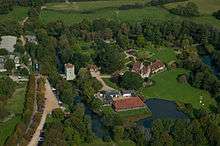
The following priors are recorded at Michelham Priory:–
- 1229 Roger.[4]
- 1239–c.1260 Peter.[19]
- 1248–68 Roger (II).[20][21]
- 1273 William.[20]
- 1278 Nicholas.[20]
- 1287 Roger (III).[20]
- 1290 Luke de la Gare.[22]
- 1302 John de Echingham†.[9]
- c.1322–34 William de Shelvestrode.[23]
- c.1376–c.1415 John Leem.[24]
- c.1434–38 William London.[25]
- 1438–c.1447 Laurence Wynchelse.[26]
- c.1450–83 Edward Marley.[27]
- 1482–c.1509 John West.[28]
- c.1518–37 Thomas Holbeme.[29]
- 1533 John[21]
† Italics denotes a possible prior.
Buildings
Barn
| Barn at Michelham Priory | |
|---|---|
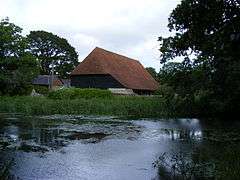 The barn. | |
| General information | |
| Status | In use as a function room |
| Type | Barn |
| Location | Michelham Priory |
| Coordinates | TQ 5581 0928 |
| Estimated completion | 1587-1610 |
| Owner | Sussex Archaeological Society |
| Height | |
| Roof | Peg tiles |
| Technical details | |
| Structural system | Timber frame |
| Material | Timber |
| Floor count | One |
| Other information | |
| Parking | Nearby |
The barn was built between 1587 and 1610.[30] It is on a timber frame clad with tarred weatherboards. The arched queen post roof is covered with pegtiles. The barn is Grade II listed.[31] The barn serves as a function and meeting room.
Chapter house and dormitory
| Chapter house and dormitory, Michelham Priory | |
|---|---|
| General information | |
| Location | Michelham Priory |
| Technical details | |
| Floor count | Two |
The chapter house and dormitory stood south of the church, on the east of the site.[32]
Church
| Michelham Priory church | |
|---|---|
| Location | Michelham Priory |
| Country | United Kingdom |
| Denomination | Augustine |
| History | |
| Founder(s) | Gilbert de Aquila |
| Architecture | |
| Status | Demolished |
| Clergy | |
| Prior | See list of priors |
The church stood to the north of the surviving refectory. It possessed five bells. No trace of it remains today.[32]
Dovecot
| Dovecot | |
|---|---|
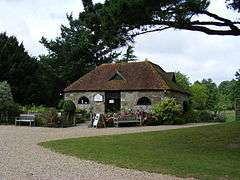 | |
| General information | |
| Address | Michelham Priory |
| Coordinates | TQ 558 093 |
| Estimated completion | C18th |
| Owner | Sussex Archaeological Society |
| Height | |
| Roof | Pegtiles |
| Technical details | |
| Material | Sandstone |
| Floor count | One |
| Other information | |
| Parking | Nearby |
The dovecot, also described as a stables or pigeon house, is a single-storey building of sandstone, ashlar on the south facing aspect under a hipped pegtile roof. Built in the C18th, it is a Grade II listed building.[33] The building has been converted to form a shop and tearoom.
Gatehouse
| Michelham Priory Gatehouse | |
|---|---|
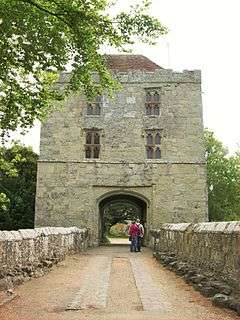 The gatehouse | |
| General information | |
| Owner | Sussex Archaeological Society |
| Height | |
| Height | c.50 feet (15 m) |
| Roof | Peg tiles |
| Technical details | |
| Material | Stone |
| Floor count | Four |
| Other information | |
| Parking | Yes |
The gatehouse was built in the early C15th,[34] during the time when John Leem was prior.[35] A basement at moat level served either as a cellar or prison.[34] The building is about 50 feet (15 m) high and contains four stories, including the cellar.[36] In the C16th, a stone bridge was built over the moat. The gatehouse and bridge are Grade I listed buildings.[37]
Refectory
| Refectory, Michelham Priory | |
|---|---|
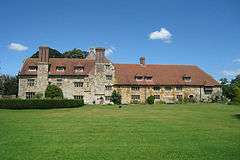 The surviving refectory (right) with Prior's house (centre) and post-monastic additions (right) | |
| General information | |
| Status | Museum |
| Estimated completion |
C13th (refectory & Prior's house) C16th (post-monastic addition) |
| Owner | Sussex Archaeological Society |
| Height | |
| Roof | Peg tiles |
| Technical details | |
| Material | Sandstone |
| Floor count |
One, later two (refectory) Three (post-monastic house) |
| Other information | |
| Parking | Nearby |
The surviving refectory building originally contained a hall 40 feet (12 m) long. There was a window at the west end which was 13 feet 6 inches (4.11 m) wide,[32] the outer frame of which survives today. This and the Prior's House are built of sandstone.[38] At the time of dissolution, the refectory was roofless. A second floor was added later and the building was divided into a number of rooms.[39] Adjacent to the refectory is the Prior's House and crypt, which was above ground on account of the low-lying position of the priory and risk of flooding.[40] There is a post-monastic extension on the west, built of stone. The whole is under a pegtile roof.[38] The refectory had been converted to use as a farmouse by 1848.[41] The crypt was divided into four rooms and used as a dairy by the 1850s.[40] The whole is a Grade I listed building.[38]
Watermill
| Priory Mill | |
|---|---|
|
Priory Mill | |
| General information | |
| Status | Preserved in working order |
| Location | Michelham Priory |
| Coordinates | TQ 557 093 |
| Owner | Sussex Archaeological Society |
| Height | |
| Roof | Peg tiles |
| Technical details | |
| Material | Timber |
| Other information | |
| Parking | Yes |
The moat round the priory was formed by damming the River Cuckmere and the watermill is fed by the moat.[42] A watermill is mentioned at Michelham Priory as early as c.1260,[20] In 1411 it was held by Robert de Blachington from William de Wrotham and his wife Joan de Kelle.[43] In 1478, the priory owned two mills, which were both reported to be "in ruins".[44] At the time the priory was dissolved, the mill produced an annual profit of 53s 3d.[45]
The surviving building dates from the mid-C16th.[46] Built on an oak frame, it is of three bays clad with weaterboards and under a pegtile roof.[47] A porch bears the date 1714. The front of the mill was renewed c.1800. A cast iron waterwheel was fitted in 1896. It was removed in 1924-25,[46] the mill having ceased commercial milling in 1924. As well as the waterwheel, the rest of the machinery was removed and the building served as a store. A turbine was installed in the mill race to generate electricity for the main house in the former refectory. It was still working in 1939.[47]
The mill was restored to working order in 1972, new machinery and a new breastshot wooden waterwheel being fitted. The mill is a Grade II listed building.[46][47] In 1996, the waterwheel was rebuilt and other machinery repaired or replaced as necessary. The work was partly funded by a £42,000 grant from the National Lottery.[47]
See also
References
- ↑ Historic England. "MICHELHAM PRIORY (1353289)". National Heritage List for England. Retrieved 14 November 2014.
- 1 2 Salzmann 1901, p. 253.
- ↑ Salzmann 1901, p. 197.
- 1 2 Salzmann 1901, p. 214.
- ↑ Salzmann 1901, p. 201.
- ↑ Salzmann 1901, p. 199.
- ↑ Cooper 1853, pp. 130-31.
- ↑ Salzmann 1901, pp. 201-02.
- 1 2 Cooper 1853, p. 144.
- ↑ Cooper 1853, p. 44.
- ↑ Salzmann 1901, p. 204.
- ↑ Cooper 1853, p. 137.
- ↑ Salzmann 1901, p. 250.
- ↑ Salzmann 1901, p. 251.
- ↑ Salzmann 1901, p. 252.
- ↑ Cooper 1853, p. 161.
- ↑ Cooper 1853, pp. 161-62.
- ↑ Pamela Cullen, "Stranger in Blood: The case files on Doctor John Bodkin Adams", 2006
- ↑ Salzmann 1901, pp. 214–15.
- 1 2 3 4 5 Salzmann 1901, p. 216.
- 1 2 Cooper 1853, p. 149.
- ↑ Salzmann 1901, p. 217.
- ↑ Salzmann 1901, p. 219.
- ↑ Salzmann 1901, p. 220.
- ↑ Salzmann 1901, p. 225.
- ↑ Salzmann 1901, p. 226.
- ↑ Salzmann 1901, p. 229.
- ↑ Salzmann 1901, p. 234.
- ↑ Salzmann 1901, p. 236.
- ↑ "MICHELHAM PRIORY". Heritagegateway. Retrieved 13 June 2016.
- ↑ "THE BARNS TO THE SOUTH WEST OF MICHELHAM PRIORY". Heritagegateway. Retrieved 13 June 2016.
- 1 2 3 Salzmann 1901, p. 239.
- ↑ "THE STABLES OR PIGEON-HOUSE TO THE NORTH WEST OF MICHELHAM PRIORY". Heritagegateway. Retrieved 13 June 2016.
- 1 2 Salzmann 1901, p. 243.
- ↑ Salzmann 1901, p. 221.
- ↑ Cooper 1853, pp. 153-54.
- ↑ "BARBICAN TOWER AND BRIDGE OVER THE MOAT AT MICHELHAM PRIORY". Heritagegateway. Retrieved 13 June 2016.
- 1 2 3 "MICHELHAM PRIORY". Heritagegateway. Retrieved 13 June 2016.
- ↑ Salzmann 1901, pp. 239-40.
- 1 2 Cooper 1853, p. 156.
- ↑ Lewis 1848, pp. 69-73.
- ↑ Cooper 1853, p. 158.
- ↑ Salzmann 1901, p. 202.
- ↑ Salzmann 1901, p. 230.
- ↑ Salzmann 1901, p. 244.
- 1 2 3 "PRIORY MILL". Heritagegateway. Retrieved 13 June 2016.
- 1 2 3 4 Stidder & Smith 1997, p. 73.
Sources
- Cooper, George Miles (1853). Some account of Michelham Priory in Arlington. Lewes: Sussex Archaeological Society.
- Samuel Lewis, ed. (1848). A Topographical Dictionary of England. London.
- Salzmann, L.F. (1901). The History of the Parish of Hailsham, The Abbey of Otham and the Priory of Michelham. London: Farncombe & Co.
- Stidder, Derek; Smith, Colin (1997). Watermills of Sussex. Volume 1, East Sussex. Baron Birch. ISBN 0 86023 569 6.
Further reading
- Michelham Priory Guide Book. Lewes: Sussex Archaeological Society. 1995.
Coordinates: 50°51′45.18″N 0°12′49.80″E / 50.8625500°N 0.2138333°E
